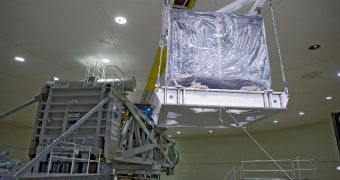The hardware structure that will support the scientific payload on the American space agency's next-generation space telescope has recently been put through its paces at a NASA science facility. The component managed to finish all assessments with flying colors.
The reason why NASA is conducting these tests is to determine whether the payload section is sufficiently resistant to withstand all the forces that will act on it during the launch. Otherwise, the telescope risks falling apart in space.
The James Webb Space Telescope (JWST) is the replacement of the Hubble Space Telescope, so it has some pretty big shoes to fill. NASA says that this observatory will be even more complex, advanced and capable than the European Space Agency's (ESA) Herschel Space Observatory.
But there is still a long way to go before the extremely innovative spacecraft can fly. At this point, the agency is focusing on getting all essential elements ready for integration with the main JWST bus.
During the weeks of May 23 and 30, the Integrated Science Instrument Module (ISIM) that will house the scientific portion of the mission, will be put through a number of spin tests. If it turns out to be durable, then the component will be accepted by NASA.
The entire project is managed by the Goddard Space Flight Center (GSFC), in Greenbelt, Maryland, for the NASA Headquarters Science Mission Directorate (SMD), in Washington DC.
“The Webb telescope will experience significant shaking and gravitational forces when it is launched on the large Ariane V rocket. The ISIM structure will house the four main scientific instruments of the telescope,” NASA experts say in a press release.
As the component is spun and shaken, GSFC engineering teams look for discrepancies between the results they are seeing and the ones they obtained in computer models of the spacecraft. If the readings corroborate each other, then everything will remain on schedule, experts say.
“The huge centrifuge will spin at speeds close to 11 rpm, exposing the ISIM structure to about 10 times the force of gravity,” which is more than enough to collect the needed data, NASA goes on to say.
The new tests come shortly after the JWST project reached another important mission milestone. On April 6, ITT Corporation engineers managed to complete the construction of a giant structural steel frame that will act as a stand for the components of the flight optics system.
The recently-finished assembly has the shape of the letter “U” and weights in excess of 139,000 pounds (63,050 kilograms). It is the basis of the entire telescope, which means that it needs to be able to support a load of 3.7 metric tons.
When completed, the JWST will be the most advanced orbital telescope ever constructed, and a fit replacement for the iconic Hubble.

 14 DAY TRIAL //
14 DAY TRIAL //